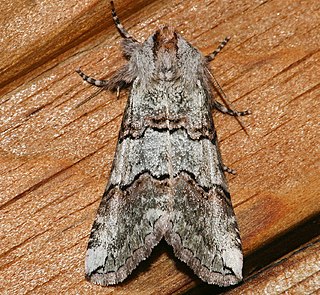
The Pyralidae, commonly called pyralid moths, snout moths or grass moths, are a family of Lepidoptera in the ditrysian superfamily Pyraloidea. In many classifications, the grass moths (Crambidae) are included in the Pyralidae as a subfamily, making the combined group one of the largest families in the Lepidoptera. The latest review by Eugene G. Munroe and Maria Alma Solis retain the Crambidae as a full family of Pyraloidea.

Crocidosema plebejana, the cotton tipworm, is a tortrix moth, belonging to tribe Eucosmini of subfamily Olethreutinae. It is found today all over the subtropical and tropical regions of the world and even occurs on many oceanic islands – in Polynesia and Saint Helena for example – but has probably been accidentally introduced to much of its current range by humans. In addition, it is also found in some cooler regions, e.g. in Europe except in the east and north; this is probably also not natural, as it was, for example, not recorded in the British Isles before 1900.
Ceranemota albertae, the Alberta lutestring, is a species of moth of the family Drepanidae first described by John Frederick Gates Clarke in 1938. It is found in western Canada, from south-central British Columbia east to south-eastern Saskatchewan. The habitat consists of dry open woodlands and shrub areas with wild cherry.

Ceranemota is a genus of moths belonging to the subfamily Thyatirinae of the Drepanidae.

Ceranemota improvisa is a moth in the family Drepanidae. It was described by Henry Edwards in 1873. It is found in North America, where it has been recorded from northern California, western Oregon, western Washington and south-western British Columbia. Adults are on wing from late September to November in one generation per year.

Ceranemota fasciata is a moth in the family Drepanidae. It was described by William Barnes and James Halliday McDunnough in 1910. It is found in North America, where it has been recorded from British Columbia to northern California. It is also present in coastal southern Alaska. The habitat consists of coastal rainforests, mixed hardwood forests and montane riparian areas.

Ceranemota crumbi is a moth in the family Drepanidae. It was described by Foster Hendrickson Benjamin in 1938. It is found in North America, where it has been recorded from western Oregon and the Washington Cascade Range. The habitat consists of coastal rainforests and mixed hardwood forests.
Ceranemota semifasciata is a moth in the family Drepanidae. It was described by Foster Hendrickson Benjamin in 1938. It is found in North America, where it has been recorded from northern California.

Ceranemota tearlei is a moth in the family Drepanidae. It was described by Henry Edwards in 1888. It is found in North America, where it has been recorded from British Columbia and central Alberta south to central California in the west and to Utah and Colorado in the Rocky Mountains. The habitat consists of higher elevation spruce-fir and mixed hardwood-conifer forests, lower elevation ponderosa pine forests, quaking aspen forests and moist riparian areas along creeks and rivers.
Ceranemota amplifascia is a moth in the family Drepanidae. It was described by John Frederick Gates Clarke in 1938. It is found in North America, where it has been recorded from California.
Agonopterix cajonensis is a moth in the family Depressariidae. It was described by John Frederick Gates Clarke in 1941. It is found in North America, where it has been recorded from California.
Agonopterix dimorphella is a moth in the family Depressariidae. It was described by John Frederick Gates Clarke in 1941. It is found in North America, where it has been recorded from South Carolina, Illinois, Nebraska, Kansas and Arkansas.
Agonopterix fusciterminella is a moth in the family Depressariidae. It was described by John Frederick Gates Clarke in 1941. It is found in North America, where it has been recorded from California to southern British Columbia, as well as from North Carolina and Tennessee.
Depressaria betina is a moth in the family Depressariidae. It was described by John Frederick Gates Clarke in 1947. It is found in North America, where it has been recorded from California to Washington.
Depressaria angustati is a moth in the family Depressariidae. It was described by John Frederick Gates Clarke in 1941. It is found in North America, where it has been recorded from Washington.
Depressaria eleanorae is a moth in the family Depressariidae. It was described by John Frederick Gates Clarke in 1941. It is found in North America, where it has been recorded from Alberta, Ontario and in Maine.
Depressaria whitmani is a moth in the family Depressariidae. It was described by John Frederick Gates Clarke in 1941. It is found in North America, where it has been recorded from California, Arizona, Washington, Colorado and Montana.
Depressaria yakimae is a moth in the family Depressariidae. It was described by John Frederick Gates Clarke in 1941. It is found in North America, where it has been recorded from Washington.
Depressaria leptotaeniae is a moth in the family Depressariidae. It was described by John Frederick Gates Clarke in 1933. It is found in North America, where it has been recorded from Oregon, Alberta, Idaho and Washington.
Depressaria multifidae is a moth in the family Depressariidae. It was described by John Frederick Gates Clarke in 1933. It is found in North America, where it has been recorded from Oregon, Washington, Idaho and California.




